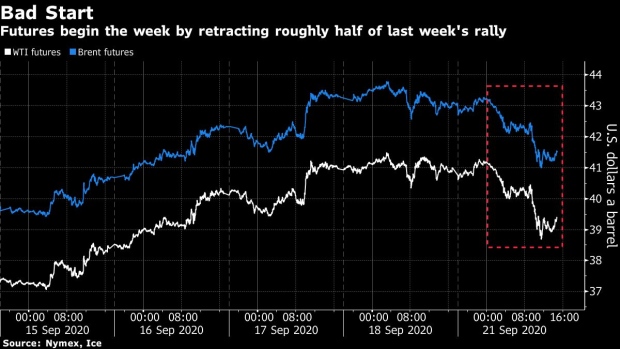Sep 21, 2020
Oil Rebounds to Near $40 as Storm Beta Approaches Texas Coast
, Bloomberg News

(Bloomberg) -- Oil pared some of Monday’s losses in Asia, with investors keeping an eye on a storm front threatening the U.S. Gulf Coast and mounting concerns over prolonged coronavirus restrictions putting risk assets broadly under pressure.
Futures in New York rallied 1%, after falling 4.4% on Monday in the biggest daily drop in almost two weeks. As U.S. deaths related to Covid-19 approached 200,000, former Food and Drug Administration Commissioner Scott Gottlieb said he expects the nation to experience “at least one more cycle” of the virus in the fall and winter. Prospects for another round of fiscal stimulus have also been damaged by a partisan battle over replacing Supreme Court Justice Ruth Bader Ginsburg. The S&P 500 led the sell off, slumping to the lowest intraday level since July.
Still, the market is wary of disruption to oil facilities from Tropical Storm Beta, with companies shutting production or evacuating staff at some platforms and the Houston Ship Channel closing. The storm has unleashed flooding on southeastern Texas and will hammer the Gulf Coast into eastern Louisiana with heavy rain, even as the storm loses power on its approach to shore.
Libya is moving closer to reopening its battered oil industry after it told companies to resume production at some fields that are free of foreign mercenaries and fighters. This will add to already rising supply from OPEC+ nations.
Here’s What to Watch as Libya’s Oil Industry Starts Up Yet Again
U.S. benchmark prices jumped 10% last week after Saudi Arabia, the most influential member of the OPEC producer bloc, sought to defend the market. But a troubling demand picture continues to weigh on the market. China National Petroleum Corp. -- the country’s biggest oil company -- sees demand for refined petroleum products peaking around 2025, while BP Plc last week became the first supermajor to call the end of the era of oil-demand growth.
©2020 Bloomberg L.P.


